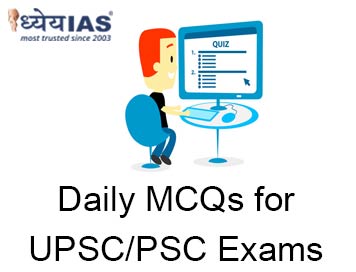Home > Daily-mcqs
Daily-mcqs 05 Jul 2025

Q1:
Which of the following statements about the Mekong-Ganga Cooperation (MGC) is/are correct? 1. It includes all the ASEAN member countries. 2. It focuses on areas like tourism, culture, education, and transportation. 3. It was launched in Vientiane, Laos in 2000. Options:
A: 1 and 2 only
B: 2 and 3 only
C: Only 1 and 3
D: 1, 2, and 3
Answer: B
Explanation:
· Statement 1 is incorrect: MGC includes India + 5 ASEAN countries (Cambodia, Laos, Myanmar, Thailand, Vietnam), not all 10 ASEAN members.
· Statements 2 and 3 are correct: Focus areas include tourism, culture, education, and transportation; it was launched in Vientiane, Laos in 2000.
Q2:
What is the main strategic rationale behind India's participation in the Mekong-Ganga Cooperation?
A: Countering China's presence in the Indo-Pacific
B: Strengthening maritime military alliances
C: Promoting historical and cultural linkages with Southeast Asia
D: Facilitating oil and gas trade in the region
Answer: C
Explanation:
MGC primarily emphasizes soft power and civilizational connections – including tourism, education, cultural exchange, and connectivity, rather than direct strategic/military objectives.
Q3:
Which of the following statements is/are correct about the Defence Acquisition Council (DAC)? 1. It is the highest decision-making body in the Ministry of Defence on procurement matters. 2. It was formed after the Kargil War based on recommendations of the Group of Ministers in 2001. 3. The Prime Minister is the ex-officio chairman of the DAC. Options:
A: 1 and 2 only
B: 2 and 3 only
C: Only 1 and 3
D: 1, 2, and 3
Answer: A
Explanation:
Q4:
The Defence Acquisition Council (DAC) is responsible for which of the following functions? 1. Approving the Long Term Integrated Perspective Plan (LTIPP) 2. Categorising defence acquisition proposals into ‘Buy’, ‘Buy & Make’, and ‘Make’ 3. Making appointments to top military posts 4. Deciding offset provisions for acquisitions above ₹300 crore Options:
A: 1, 2 and 3 only
B: 1, 2 and 4 only
C: 2 and 4 only
D: All of the above
Answer: B
Explanation:
The DAC gives in-principle approval to the 15-year Long Term Integrated Perspective Plan (LTIPP), which outlines the long-term capability requirements of the Indian Armed Forces. Thus statement 1 is correct.
One of DAC’s core roles is to categorize procurement proposals under appropriate acquisition categories such as:
· Buy (Indian/Global)
· Buy & Make
· Make/Make-I/Make-II
This helps streamline procurement and promote indigenous development where possible. Thus statement 2 is correct.
The DAC does not appoint military officials. Appointments to top military positions (e.g., Chiefs of Army, Navy, Air Force, CDS) are made by the Appointments Committee of the Cabinet (ACC), headed by the Prime Minister. Thus statement 3 is incorrect.
For defence procurement proposals above ₹300 crore, DAC is empowered to take decisions related to offset obligations — a mechanism to promote local defence industry and technology transfer through foreign deals. Thus statement 4 is correct.
Q5:
Which of the following is the correct vision target for India's chemical sector by 2040, as per NITI Aayog’s report?
A: Achieve $500 billion in chemical output
B: Capture 6% of the global chemical value chains
C: Generate 7 lakh jobs
D: Reach $1 trillion chemical industry output
Answer: D
Explanation:
The vision for 2040 aims for a $1 trillion chemical industry and capturing up to 12% of global chemical GVCs.